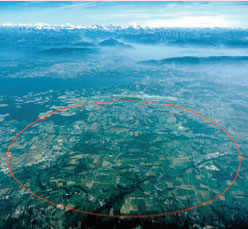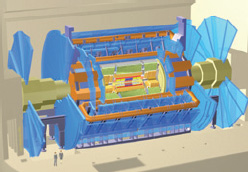 |
600 US scientists
+
3500 scientists
from other countries
=
The New
High-Energy Frontier
by Kurt Riesselmann
| In less than three years, scientists will start up the world's largest scientific instrument: The Large Hadron Collider. US scientists have built key components for the machine and its experiments, paving the way for their participation in a decade of discoveries. |
In December 1997, the United States signed a half-billion-dollar commitment for one of the largest international scientific collaborations ever undertaken: the construction of the Large Hadron Collider (LHC) at the European particle physics laboratory CERN in Geneva, Switzerland. When complete, the 27-kilometer ring-shaped collider will delve deep into the mysteries of the sub-atomic world, unraveling the structure of matter, space and time at the tiniest scales. From extra dimensions to miniature black holes, from the mass-creating Higgs mechanism to heavy super-symmetric particles predicted by theorists, the LHC is the gateway to a new era of discovery.
The United States contributes high-tech accelerator and detector components, developed and built by US national laboratories with some help from industry. Two federal agencies have shared the cost and administered the eight-year project: the Department of Energy ($450 million) and the National Science Foundation ($81 million).
Except for the final assembly in the LHC tunnel, US scientists will have fulfilled their commitment by early 2006, shipping superconducting magnets and other precision instruments to CERN. The installation of the various components will occur over the next couple of years, fitting into the overall LHC schedule.
In 2007, the LHC will begin to produce collisions seven times more powerful than the Tevatron at Fermilab, currently the world's highest-energy accelerator. Huge "particle cameras"detectors larger than a five-storey house will take snapshots of the subatomic messengers emerging from the debris of proton-proton collisions. The flood of data on the new energy frontier will allow scientists to take big leaps toward understanding the forces and the particles that govern the universe.
"The Large Hadron Collider is an extraordinary technological enterprise and presents great scientific opportunities," says Raymond Orbach, director of DOE's Office of Science. "US scientists and engineers have made great contributions to both the LHC and its detectors, enabling them to remain world leaders in particle physics research. They will be directly involved in the greatest scientific adventure of our time: exploring the very nature of matter and energy present at the [universe's] creation. Whether it be in the form of the Higgs boson, or the supersymmetric partners of the particles we know today, US scientists will contribute at the most fundamental level to our knowledge of the origin of our universe."
Huge collaborations
Approximately 600 US scientists now participate in the two largest LHC experiments: ATLAS (A Toroidal LHC ApparatuS) and CMS (based on a Compact Muon Solenoid). More US scientists are going to join the LHC collaborations because the CDF and DZero collider experiments at Fermilab will stop running when the LHC begins to produce scientific results.
Working on the two LHC experiments, US scientists are collaborating with another 3500 scientists from approximately 40 countries, making these the two largest scientific collaborations in history.
"Particle physics has traditionally been very international," says ATLAS physicist Michael Tuts of Columbia University, also a member of the 600-physicist DZero collaboration. "The CDF and DZero experiments have received large contributions from non-US institutions. It's been one of the strengths of particle physics that we ignore borders."
Building the racetrack
At the LHC, two beams of protons will race in opposite directions, crossing at the center of the detectors. (The construction of two of these detectorsALICE and LHCbreceives no significant US funding.) To steer the protons, which travel close to the speed of light, scientists use thousands of powerful superconducting magnets, cooled to ultracold temperature using liquid helium.
Three DOE national laboratoriesFermilab, Brookhaven, and Lawrence Berkeleyhave participated in the $200 million project to build nine sets of beam-focusing systems, each 40 meters long. In collaboration with CERN, the Japanese research center KEK, and US industry, the laboratories have built superconducting dipole and quadrupole magnets, instrumentation, and the distribution systems for power and cooling.
A large fraction of the US-built focusing components has already been shipped to Switzerland. The magnets "squeeze" the width of the two proton beams to less than the diameter of a hair and focus the beams into the center of the collision detectors, thus maximizing the number of head-on proton-proton collisions. According to Ranko Ostojic, CERN, the first complete focusing system will go into the LHC tunnel in September.

| High-energy collisions can create new types of particles, including those that are heavier than the incoming ones. |
 The 27-kilometer LHC tunnel is located between 50 and 150 meters underground, crossing the French-Swiss border. Photo: CERN |
 The ATLAS detector, larger than a five-storey house, is currently under construction. Image: CERN |
Strange collisions
Colliding two high-energy protons is like colliding two carsand out fly motorbikes, trucks, and SUVs. Welcome to the quantum world and Einstein's famous equation E=mc2. The powerful collisions break up the incoming protons and transform the released energy into new, short-lived particles that can bein the case of the LHCthousands of times heavier than a single proton. For a tiny amount of time, the collisions recreate processes that occurred in the early universe, producing particles that were abundant after the big bang.
Because of the short lifetimes of these heavy, exotic particles, scientists are unable to observe them directly. Instead, they record with high precision the flight paths of hundreds of secondary particles: the decay products emerging from the collision center. Tracking these trajectories back to the collision region, scientists determine the type and the mass of the short-lived particles, and deduce the forces influencing their quantum behavior.
High-tech for quick snapshots
Measuring hundreds of particle tracks and other information within a billionth of a second requires detectors that are among the largest scientific instruments ever built. As part of the US-CERN agreement, the United States is providing about $320 million in equipment for the ATLAS and CMS detectors, divided evenly between the two. The money pays for the development and construction of many different particle detection systems. For example, the US CMS collaboration has designed and built a $44-million hadron calorimeter, which measures the energy of quark-containing particles escaping the collision region.
US scientists are now conducting final tests of all of their equipment before it is moved into the LHC tunnel.
"Once you go underground, it's like the ship in the bottle," says Fermilab physicist Dan Green, US CMS project manager. "So far, the US CMS collaboration has been a great success. We've met all deadlines, and we were even able to increase the scope of our contributions while staying within budget."
Towers of CDs
Installation of the equipment is not the end of the US involvement in the LHC experiments.
"You built it, you installed it, now you have to see that it works," says Tuts, who is one of the managers of the US ATLAS research program. "The [funding for the] research program is on a ramp up. About half the money is for physics software and computing, and the other half is for maintenance."
To test its detector, the ATLAS collaboration has created simulations of ten million proton-proton collisions, producing an amount of data that would fill more than 70,000 CDs. When the real experiment starts, physicists will record data twenty-four hours a day at a rate of 320 megabytes per second, enough information to fill a CD every two seconds.
Plugging into the Grid
Processing these large amounts of simulated and real collision data requires a completely new way of computing: the Grid. Like plugging into the electric power supply grid, LHC scientists are using a still-expanding computing grid of their own to access vast amounts of computing power without needing to know the specific computing sources. The vision and the demands of the global Grid have engaged Information Technology experts from around the world.
"The LHC program is a cutting-edge program," says Green. "It is globally distributed, and it has a large data volume. We get a lot of buy-in from IT groups at the funding agencies and the universities. They want to participate because it is an interesting challenge with applications in many other areas of research."
Beyond 2007
In less than three years, the first proton beams will circle the LHC tunnel. But it will take some time before the collider achieves its design performance.
"Accelerators are not like light switches that you flip and that will be on," says Steve Peggs, accelerator expert at Brookhaven National Laboratory. "We are confident that the LHC will work, but we do not exactly know what the limiting performance factors will be. The LHC is a challenging machine and it will take two to three years to achieve full performance."
To maximize the number of collisionsand hence the scientific productivity of the LHC programaccelerator experts have begun to discuss potential upgrades to various parts of the machine. Scientists from Brookhaven, Fermilab, Lawrence Berkeley and Stanford Linear Accelerator Center are participating through the US LHC Accelerator Research Program, which in the future will receive approximately $10 million per year. The program will help to train the next generation of accelerator experts in the United States.
"Discoveries at the LHC will start a revolution in our understanding of particle physics," says Fermilab Director Michael Witherell. "Scientists from the United States must be fully involved in making these discoveries if we are to remain at the forefront of particle physics and accelerator technology. LHC research will be central to Fermilab and to US particle physics for a very long time."
Click here to download the pdf version of this article.






